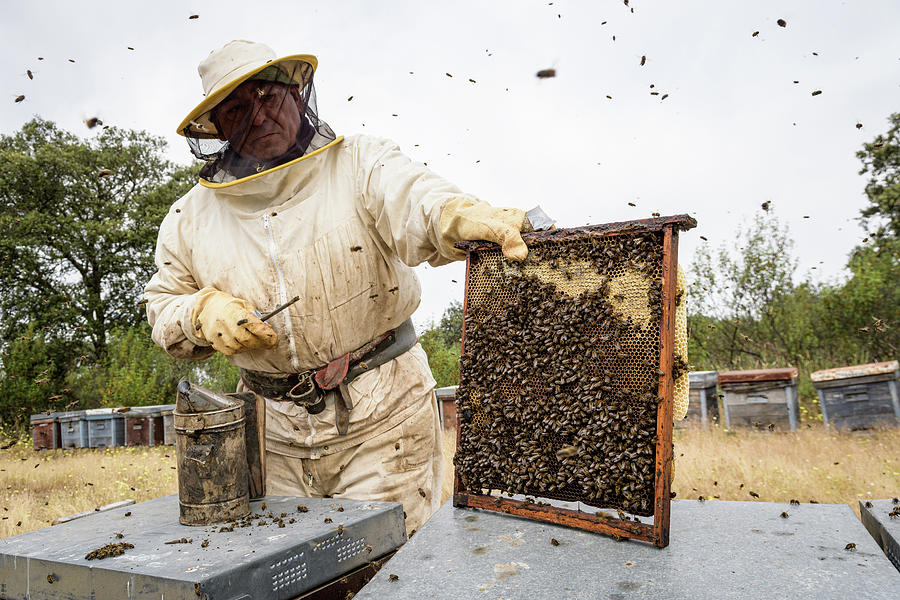Beekeeping for Honey Production and Pollination: A Guide to Rural Living
In the world of rural living and homesteading, beekeeping has grown in popularity as an essential practice. Not only does it provide a sustainable source of honey, but it also plays a crucial role in pollination. With the decline in global bee populations, more and more people are taking up this ancient craft to support their local ecosystems and enjoy the sweet rewards that come with it.
Beekeeping is an art that dates back thousands of years, with evidence found in ancient Egyptian hieroglyphs and Greek mythology. Today, modern beekeepers use innovative techniques while still honoring traditional practices to maintain healthy colonies.
The first step for aspiring beekeepers is acquiring the necessary equipment. Basic tools include a beehive (also known as an apiary), frames or foundation sheets where bees build their wax comb, protective clothing like veils and gloves, smokers to calm bees during inspections, hive tools for manipulating frames, and feeders for supplementary feeding if needed.
Selecting the right location for your apiary is crucial. Bees thrive in areas abundant with nectar-producing flowers from which they collect pollen and nectar. Ideally, choose a spot away from heavy foot traffic or animal disturbances while ensuring easy access for management tasks.
When it comes to choosing bee breeds or species, there are several options available depending on your goals as a beekeeper. The most common honeybee species used worldwide is Apis mellifera due to its docile nature and high honey production capabilities. However, some regions may have local varieties that are better suited to their specific climate conditions.
Once you’ve set up your hives and selected your bees, regular maintenance becomes essential. Beekeepers must monitor hive health by conducting routine inspections every few weeks during warmer months when activity is at its peak. Inspections involve checking for signs of disease or pests such as Varroa mites, which can severely impact bee colonies.
Honey production is one of the main reasons people undertake beekeeping. Bees produce honey by collecting nectar from flowers and converting it into a concentrated sugar solution through regurgitation and evaporation. Beekeepers harvest honey by removing frames filled with capped cells from the hive, extracting the honey using centrifugal force, and then bottling it for consumption.
Apart from honey, bees are also vital as pollinators. They play a crucial role in fertilizing plants by transferring pollen between male and female flower parts. This process allows plants to reproduce and create fruits, vegetables, nuts, seeds, and other crops that we rely on for food. Without bees’ pollination services, many plant species would struggle to survive.
Beekeepers contribute significantly to agricultural productivity through their managed hives placed near farms or orchards during bloom periods. Farmers often rent beehives to ensure sufficient pollination for their crops such as apples, almonds, cherries, blueberries, and cucumbers. This collaboration benefits both parties: farmers increase yields while beekeepers provide their colonies with diverse sources of nectar.
In recent years, concerns about declining bee populations have gained attention worldwide due to factors like habitat loss, pesticide use in agriculture, climate change effects on flowering patterns, parasites like Varroa mites mentioned earlier,and diseases like Colony Collapse Disorder (CCD). CCD is a phenomenon where entire colonies suddenly die off without any apparent cause. It highlights the importance of sustainable practices in beekeeping that prioritize colony health over maximum honey yield.
To maintain healthy colonies and support overall bee population conservation efforts:
1) Provide ample forage: Plant native wildflowers or cultivate gardens with a variety of blooming plants throughout the seasons to offer bees abundant sources of nectar and pollen.
2) Avoid pesticide use: If pesticides are necessary in your garden or farming operation,
choose less harmful alternatives and apply them during non-flowering periods when bees are less active.
3) Monitor for pests and diseases: Regularly check hives for signs of infestations, diseases, or parasites. If detected, take appropriate action promptly to prevent further spread or damage.
4) Practice swarm prevention: Swarming is a natural process where bees divide their colony by creating a new queen and leaving the hive with a portion of the population. While swarming is normal behavior, it can be disruptive if not managed properly. Regular inspections and proper hive management techniques can help prevent swarming.
Beekeeping offers numerous benefits to rural living enthusiasts. Beyond honey production, beekeepers contribute to pollination efforts that directly impact ecosystem health and food production. By adopting sustainable practices and supporting healthy bee populations, we can ensure the survival of these essential pollinators while enjoying the sweet rewards they provide.


Leave a comment